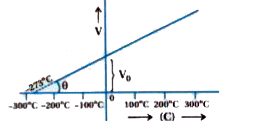The mathematical from of Chart.s law is given under Vt=V0(273.15+t∘C273∘C), From this equation explain V→T in Kelvin. Solution in Gujrati
Vt=V0(273.15+t273.15) ….(Eq. -i)
∴Vt=V0(273)273+V0t∘C273
∴Vt=V0+(t∘C273)V0 …..(Eq. -ii)
As per equation Y=C+mx
∴ The graph of volume (V)→ Temperature in Kelvin.
Where, slope =tanθ=V0273, Intercept =V0
Upward graph is straight.

Topper's Solved these Questions
- BOOK - KUMAR PRAKASHANCHAPTER - STATES OF MATTER EXERCISE - SECTION - A QUESTIONS (Sub Question)3videos
STATES OF MATTER
- BOOK - KUMAR PRAKASHANCHAPTER - STATES OF MATTER EXERCISE - SECTION - A QUESTIONS (TRY YOUR SELF)47videos
STATES OF MATTER
- BOOK - KUMAR PRAKASHANCHAPTER - SOME BASIC CONCEPTS OF CHEMISTRYEXERCISE - Section - D (Solutions of NCERT Exemplar Problems) (Long Answer Type Questions)4videos
SOME BASIC CONCEPTS OF CHEMISTRY
- BOOK - KUMAR PRAKASHANCHAPTER - STRUCTURE OF ATOMEXERCISE - QUESTINS PAPER FROM MODULE (SECTION -D)2videos
STRUCTURE OF ATOM
Similar Questions
Derive Boyle.s formula according to his law.
03:04View SolutionAt 300 K constant temperature gas having 20cm3, 1 bar pressure it is convert into 50cm3 then calculated pressure ?
01:22View SolutionA vessel contains 1.6 g of dioxygen at STP (273.15 K, 1 atm pressure). The gas is now transferred to another vessel at constant temperature, where pressure becomes half of the original pressure. Calculate
(A) volume of the new vessel.
(B) number of molecules of dioxygen.View SolutionExplain Heisenberg’s uncertainty principle.
02:24View SolutionThe velocity of a particle is given by v=v_(0) sin omegat , where v_(0) is constant and omega=2pi//T . Find the average velocity in time interval t=0 to t=T//2.
02:24View SolutionThe position of a particle at time t, is given by the equation, x(t) = (v_(0))/(alpha)(1-e^(-alpha t)) , where v_(0) is a constant and alpha gt 0 . The dimensions of v_(0) & alpha are respectively.
04:05View SolutionIn the above question if V_(S)(t)=220sqrt2 sin (2pi 50 t) , find (a) l(t) ,(b) v_(R) and (c ) v_(C)(t)
02:51View Solutionनिम्नलिखित समीकरण किस नियम को दर्शाती है ?
Vt=V0(1+t273)
इस नियम को अन्य प्रकार से परिभाषित कीजिए ।06:54View Solutionनिम्नलिखित समीकरण किस नियम को दर्शाती है ?
Vt=V0(1+t273)
इस नियम को अन्य प्रकार से परिभाषित कीजिए ।02:31View Solutionएक वस्तु एक क्षैतिज सतह पर आगे की ओर फिसलती हुई लुढ़कती (rolling with forward slipping) है। इसके केंद्र का वेग vc तथा सबसे ऊपर के बिंदु का वेग vt है। तब क्या vt>2vc या vt<2vc या vt=2vc होगा ?
02:51View SolutionThe position of a particle at time t is given by the equation x(t) = V_(0)/A (1-e^(At)) V_(0) = constant and A > 0 Dimensions of V_(0) and A respectively are
04:36View Solutionकोई लघु सिग्नल वोल्टता V(t)=V0sinωt किसी संधारित्र C के सिरों पर प्रयुक्त की गई है -
02:51View SolutionWhich of the following indicates Charles' law mathematically (when n, P are constant)?
1) VT = constant
2) V1=V0(t+1273)
3) V0=V1(1+1273)
4) V/T = constant (when n,P are constant)04:14View SolutionThe position of a particle at time t is given by the equation X(t)=(V_(0))/(A)(1-e^(At)) V_(0) = constant and A gt 0
03:50View SolutionA small signal voltage V(t)=V_(0)sin omega t An ideal capacitor is applied at the ends of C:
02:15View Solution

